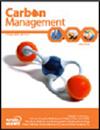受人口增长、土地可用性、粮食生产和气候变化限制的土壤固碳潜力
IF 3.2
4区 环境科学与生态学
Q3 ENVIRONMENTAL SCIENCES
引用次数: 0
摘要
本文章由计算机程序翻译,如有差异,请以英文原文为准。
Soil carbon sequestration potential bounded by population growth, land availability, food production, and climate change
Abstract Improving soil management to enhance soil carbon sequestration (SCS)—a cost-efficient carbon dioxide (CO2) removal approach—can result in co-benefits or trade-offs. Here we address this issue by setting up a modeling framework for Switzerland that combines soil carbon (C) storage, food production and agricultural greenhouse gas (GHG) emissions. The link to food production is crucial because crop types and livestock numbers influence soil organic C (SOC) stocks, through soil C inputs from plants and manure. We estimated SCS rates for the years 2020–2050 for three scenarios, each with two variants for biochar: cover cropping (0.30 t CO2 equivalents [CO2-eq] ha−1 yr−1), biochar addition (0.36–1.8 t CO2-eq ha−1 yr−1) and agroforestry-biochar addition (2.2–2.3 t CO2-eq ha−1 yr−1). Different limiting factors (land and biomass availability, population growth) affected SCS rates and indicated that they cannot be sustained until 2100 under all scenarios (cover cropping: 0.10 t CO2-eq ha−1 yr−1 [2051–2100]; biochar addition: 0.35–1.8 t CO2-eq ha−1 yr−1; agroforestry-biochar addition: 1.0–1.7 t CO2-eq ha−1 yr−1). This information together with the associated GHG emissions is critical for planning net zero strategies and highlights the importance of integrated assessments that capture links between SCS and the food system.
求助全文
通过发布文献求助,成功后即可免费获取论文全文。
去求助
来源期刊

Carbon Management
ENVIRONMENTAL SCIENCES-
CiteScore
5.80
自引率
3.20%
发文量
35
期刊介绍:
Carbon Management is a scholarly peer-reviewed forum for insights from the diverse array of disciplines that enhance our understanding of carbon dioxide and other GHG interactions – from biology, ecology, chemistry and engineering to law, policy, economics and sociology.
The core aim of Carbon Management is it to examine the options and mechanisms for mitigating the causes and impacts of climate change, which includes mechanisms for reducing emissions and enhancing the removal of GHGs from the atmosphere, as well as metrics used to measure performance of options and mechanisms resulting from international treaties, domestic policies, local regulations, environmental markets, technologies, industrial efforts and consumer choices.
One key aim of the journal is to catalyse intellectual debate in an inclusive and scientific manner on the practical work of policy implementation related to the long-term effort of managing our global GHG emissions and impacts. Decisions made in the near future will have profound impacts on the global climate and biosphere. Carbon Management delivers research findings in an accessible format to inform decisions in the fields of research, education, management and environmental policy.
 求助内容:
求助内容: 应助结果提醒方式:
应助结果提醒方式:


